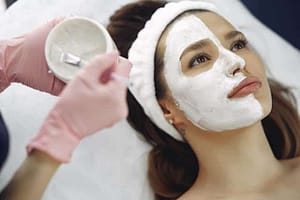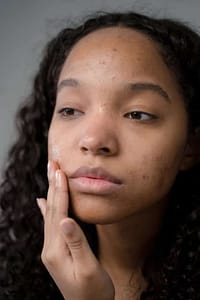Understanding Hormonal Skin Changes
Impact of Hormones on Skin
Beyond external factors like the sun and pollution, hormonal skin changes are significantly influenced by your internal hormonal environment. Hormones are chemical messengers that orchestrate various physiological processes, including growth, metabolism, reproduction, and stress response. These messengers bind to specific receptors on target cells, triggering alterations in gene expression, enzyme activity, and numerous cellular functions, ultimately impacting skin health and appearance
As you experience hormonal fluctuations, your skin’s appearance and health can change dramatically. During certain phases of your life, such as puberty, menstruation, pregnancy, and menopause, these fluctuations are more pronounced, leading to noticeable skin changes. Estrogen, for example, promotes hydration and elasticity, while testosterone can increase oil production. Learning how to navigate these hormone-induced transitions can help you maintain a radiant complexion.
Menstrual Cycle and Skin Health
Each month, your menstrual cycle presents a sequence of hormonal shifts that can manifest in your skin. During the initial days (Day 1-6), when estrogen, progesterone, and testosterone are at their lowest, you might notice your skin becoming drier and duller, with an uptick in sensitivity. It’s a good time to focus on hydration with the right moisturizer (Axiawh).
As you approach ovulation (Day 12-16), estrogen peaks, often blessing you with a healthy, glowing complexion. However, it’s wise to resist the temptation to overindulge in skincare products or treatments during this phase, as your skin is already at its optimal state.
Following ovulation, progesterone takes the lead, and you might find your skin becoming oilier, paving the way for acne breakouts and heightened sensitivity. This is a pivotal time to be diligent with your skincare routine, utilizing non-comedogenic products and perhaps exploring treatment options for hormonal acne.
| Menstrual Cycle Phase | Estrogen Levels | Skin Condition |
|---|---|---|
| Day 1-6 | Low | Dry, Dull, Sensitive |
| Day 12-16 | High | Healthy, Glowing |
By understanding how your hormones ebb and flow throughout your cycle, you can tailor your skincare practices to align with your body’s needs. Whether it’s adapting your moisturizing habits or managing breakouts, acknowledging the link between hormones and skin health is key to nurturing your complexion. For more insights into how hormonal changes can affect your skin at different life stages, explore our articles on skin changes during puberty, skin changes during perimenopause, and skin changes after childbirth.
Skin Changes During Menopause
Menopause is a significant transition in a woman’s life, and it brings about numerous changes, including in your skin. Understanding these hormonal skin changes can help you adjust your skincare routine to better suit your needs during this time.
Effects of Decreased Estrogen
During menopause, your body experiences a decrease in estrogen levels, which can profoundly impact skin health. Estrogen plays a key role in maintaining skin moisture, strength, and elasticity. With lower estrogen levels, you may notice your skin becomes drier, thinner, and less resilient. Collagen, a structural protein that keeps skin firm, decreases significantly; studies suggest women may lose about 30% of their collagen during the first five years of menopause (Axiawh). This loss can lead to facial volume loss, decreased skin thickness, and the development of fine lines and wrinkles.
Additionally, menopausal hormonal changes can also lead to bone loss, which may affect facial structure and skin sagging (Hormone Health). Alongside these changes, you may notice an increase in age spots and a slower healing process for your skin.
Recommended Skincare for Menopause
To address the challenges your skin faces during menopause, it’s crucial to adopt a skincare regimen that focuses on hydration and nourishment. Look for products that contain ingredients like hyaluronic acid, glycerin, and ceramides, which help to hydrate and reinforce the skin’s barrier function. Products with peptides and retinoids may also be beneficial, as they can stimulate collagen production and improve skin texture.
It’s equally important to protect your skin from the sun’s harmful UV rays, as menopausal skin is more susceptible to damage. Use a broad-spectrum sunscreen with at least SPF 30 daily to prevent further age spots and wrinkles (Bend Dermatology).
Maintaining a consistent skincare routine during menopause can help manage these hormonal skin changes effectively. Here are some recommended steps for your skincare routine:
- Gentle Cleansing: Opt for a hydrating cleanser to remove impurities without stripping your skin of its natural oils.
- Serum: Apply a serum rich in antioxidants and hydrating agents to address dryness and improve skin health.
- Moisturizing: Use a nourishing moisturizer to lock in hydration and protect the skin barrier.
- Sun Protection: Apply sunscreen every morning as the final step in your skincare routine to shield your skin from UV radiation.
Remember, your skin needs may change as you go through menopause. Listen to your skin, and don’t hesitate to consult a dermatologist for personalized advice. For more information on managing hormonal skin changes, explore our articles on skin changes during perimenopause, skin changes and stress, and skin changes and nutrition. Staying informed and proactive about your skincare can help you navigate menopause with confidence and grace.
Hormonal Acne in Women
Hormonal acne is a prevalent skin condition that you might encounter, especially as you navigate through various life stages such as menstruation, pregnancy, and menopause. Understanding the causes and triggers, as well as effective treatment options, can empower you to manage this condition more effectively.
Causes and Triggers
Hormonal acne in women primarily arises due to fluctuations in hormone levels. During certain times in your life, such as your menstrual cycle, pregnancy, or menopause, the balance between estrogen and progesterone shifts, which can lead to an increase in androgens. High levels of androgens can cause excess sebum production, leading to clogged pores when combined with dead skin cells, ultimately resulting in acne.
It’s also worth noting that conditions like polycystic ovarian syndrome (PCOS) can elevate androgen levels, making you more susceptible to acne, as well as other symptoms like excess hair growth and hair loss. Acne outbreaks are particularly common during the perimenstrual phase (the 10 days before your period, plus days of bleeding), which is a window where hormonal fluctuations are at their peak (Clue).
Treatment Options for Hormonal Acne
When it comes to treating hormonal acne, there are several options available that target the hormonal contributors to the condition. Here are some of the most common treatment approaches:
- Oral Contraceptives: Birth control pills containing ethinyl-estradiol can help regulate your menstrual cycle, suppress ovulation, and reduce the production of ovarian androgens, which in turn can help manage acne breakouts.
- Anti-Androgen Drugs: Medications such as spironolactone work by balancing your hormones and are particularly effective in treating acne caused by hormonal imbalances.
Hormonal acne lesions are often inflamed and can appear on the cheeks, jawline, as well as the shoulders, chest, and back. These lesions can be red, painful, or sore, which highlights the importance of gentle yet effective treatment strategies.
| Treatment Option | Target | Common Forms |
|---|---|---|
| Oral Contraceptives | Hormone Regulation | Pills |
| Anti-Androgen Drugs | Hormone Balancing | Pills |
In addition to these medical treatments, maintaining a healthy skin care routine tailored to your skin type is crucial. Incorporating non-comedogenic products, ensuring adequate hydration, and addressing nutrition can also contribute to healthier skin.
Remember, while hormonal acne can be challenging, there are effective treatments available to help you manage it. If you’re struggling with acne or other hormonal skin changes, consult with a dermatologist to find a treatment plan that works best for you.
Hormonal Imbalances and Skin Conditions
Hormonal imbalances can profoundly influence your skin’s health, affecting its appearance and texture. Understanding how these fluctuations impact your skin can help you manage symptoms more effectively.
Impact on Skin Health
Hormones are chemical messengers that regulate many of your body’s functions, and they have a significant role in maintaining skin health. They interact with receptors on skin cells, influencing gene expression and cellular processes that determine your skin’s condition. When your hormones are balanced, your skin is more likely to appear vibrant and healthy. However, an imbalance can lead to several skin issues.
For example, menopausal hormonal changes can lead to a decrease in skin thickness, loss of collagen, and increased facial sagging and wrinkles. Within the first five years of menopause, women may lose about 30% of their skin’s collagen, leading to visible signs of aging (Axiawh). Consulting with dermatology providers is advisable to determine if hormones could be a contributing factor to your skin problems (Bend Dermatology).
Symptoms of Hormonal Skin Issues
Hormonal imbalances can manifest in several skin-related symptoms, particularly in those assigned female at birth. Some of the issues you might notice include:
- Hormonal Acne: Fluctuations in hormones such as oestrogen, progesterone, and testosterone can escalate sebum production, leading to clogged pores and breakouts, often on the face, back, or chest.
- Dryness and Wrinkles: Changes, especially during menopause, can result in drier skin and more pronounced fine lines or wrinkles due to decreased estrogen levels.
- Skin Thickness and Elasticity: Reduced collagen production can impact the thickness and elasticity of your skin, causing it to appear less firm and supple.
- Hyperpigmentation: Hormonal fluctuations may also lead to changes in skin pigmentation, such as melasma or age spots.
It’s essential to recognize these signs and understand that hormonal fluctuations can occur at various life stages, including during the menstrual cycle, pregnancy, perimenopause, menopause, after childbirth, and even in stress response. Additionally, your nutrition and hydration levels can influence your hormonal balance and, consequently, your skin health.
If you are experiencing any of these symptoms and suspect they may be related to hormonal imbalances, it is crucial to seek professional advice. A healthcare provider can help determine the underlying causes and recommend appropriate treatment options to help manage and improve your skin’s condition.


